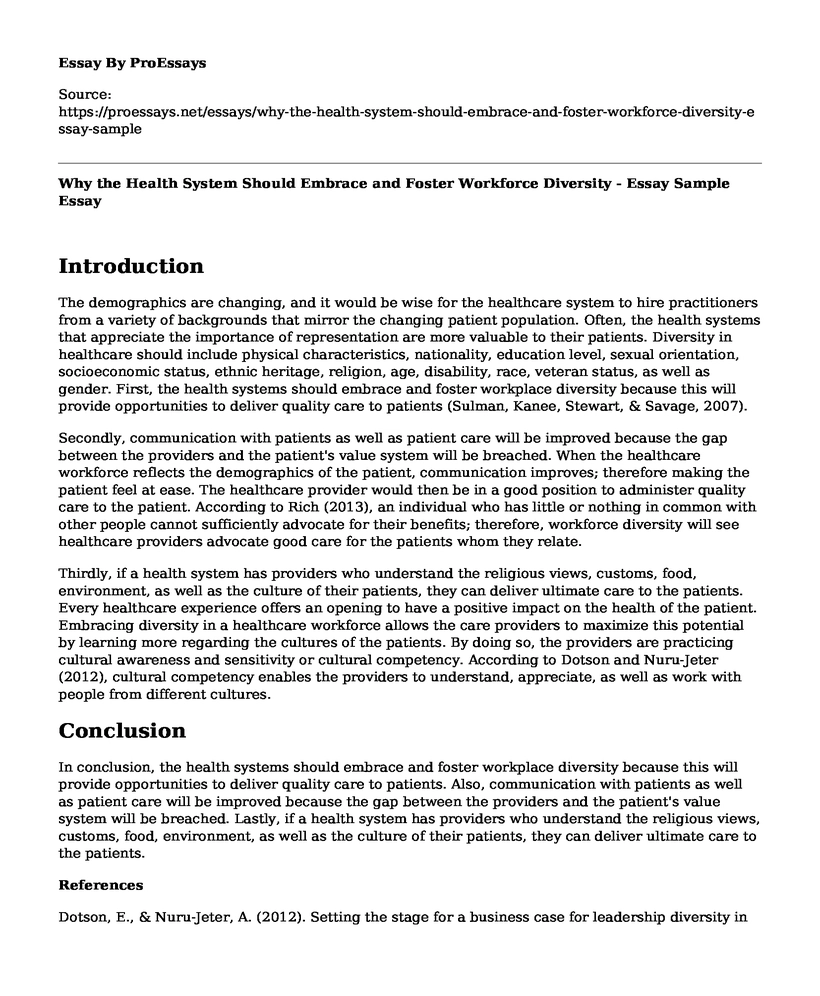Introduction
The demographics are changing, and it would be wise for the healthcare system to hire practitioners from a variety of backgrounds that mirror the changing patient population. Often, the health systems that appreciate the importance of representation are more valuable to their patients. Diversity in healthcare should include physical characteristics, nationality, education level, sexual orientation, socioeconomic status, ethnic heritage, religion, age, disability, race, veteran status, as well as gender. First, the health systems should embrace and foster workplace diversity because this will provide opportunities to deliver quality care to patients (Sulman, Kanee, Stewart, & Savage, 2007).
Secondly, communication with patients as well as patient care will be improved because the gap between the providers and the patient's value system will be breached. When the healthcare workforce reflects the demographics of the patient, communication improves; therefore making the patient feel at ease. The healthcare provider would then be in a good position to administer quality care to the patient. According to Rich (2013), an individual who has little or nothing in common with other people cannot sufficiently advocate for their benefits; therefore, workforce diversity will see healthcare providers advocate good care for the patients whom they relate.
Thirdly, if a health system has providers who understand the religious views, customs, food, environment, as well as the culture of their patients, they can deliver ultimate care to the patients. Every healthcare experience offers an opening to have a positive impact on the health of the patient. Embracing diversity in a healthcare workforce allows the care providers to maximize this potential by learning more regarding the cultures of the patients. By doing so, the providers are practicing cultural awareness and sensitivity or cultural competency. According to Dotson and Nuru-Jeter (2012), cultural competency enables the providers to understand, appreciate, as well as work with people from different cultures.
Conclusion
In conclusion, the health systems should embrace and foster workplace diversity because this will provide opportunities to deliver quality care to patients. Also, communication with patients as well as patient care will be improved because the gap between the providers and the patient's value system will be breached. Lastly, if a health system has providers who understand the religious views, customs, food, environment, as well as the culture of their patients, they can deliver ultimate care to the patients.
References
Dotson, E., & Nuru-Jeter, A. (2012). Setting the stage for a business case for leadership diversity in healthcare: History, research, and leverage. Journal of Healthcare Management, 57(1), 35-46. doi: 10.1097/00115514-201201000-00007
Rich, V. L. (2013). Advancing diversity leadership in health care. Nursing administration quarterly, 37(3), 269-271. doi: 10.1097/naq.0b013e318296923d
Sulman, J., Kanee, M., Stewart, P., & Savage, D. (2007). Does difference matter? Diversity and human rights in a hospital workplace. Social work in health care, 44(3), 145-159. doi: 10.1300/j010v44n03_02
Cite this page
Why the Health System Should Embrace and Foster Workforce Diversity - Essay Sample. (2022, Dec 12). Retrieved from https://proessays.net/essays/why-the-health-system-should-embrace-and-foster-workforce-diversity-essay-sample
If you are the original author of this essay and no longer wish to have it published on the ProEssays website, please click below to request its removal:
- Research Paper on Issue of Shortage of Nurses in the Health Care System
- Supplements for Strength-Power Athletes Paper Example
- Response to the Article "Why Are Drugs Cheaper in Europe?" Paper Example
- Research Paper on Association Between Vaccines and Autism
- Paper Example on Vitamin D Supplementation in Children With IBS and Other Chronic Diseases
- Essay Example on Climate Change: Floods as a Severe Issue in the USA
- Myocardial Infarction: A Case Study on a 64-Year-Old Patient with Mechanical Complications







